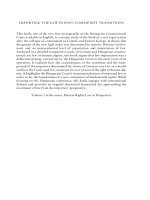Immobilizing catalysts in continuous flow micro reactors polymer encapsulated metals and engineered biofilms
Bạn đang xem bản rút gọn của tài liệu. Xem và tải ngay bản đầy đủ của tài liệu tại đây (6.77 MB, 240 trang )
IMMOBILIZING CATALYSTS IN CONTINUOUS
FLOW MICRO-REACTORS: POLYMER
ENCAPSULATED METALS AND ENGINEERED
BIOFILMS
NG JECK FEI
(B. Sc. (Hons), Universiti Teknologi Malaysia)
A THESIS SUBMITTED
FOR THE DEGREE OF DOCTOR OF PHILOSOPHY
DEPARTMENT OF CHEMISTRY
NATIONAL UNIVERSITY OF SINGAPORE
2011
Acknowledgement
A doctoral thesis like this which involves knowledge from various
fields, would not be possible without the help of many people. It has been a
truly memorable learning journey in completing the research work. Therefore,
I would like to take this opportunity to acknowledge those who have been
helping me along the way.
First, I would like to express my greatest gratitude to Associate
Professor Stephan Jaenicke for giving me the opportunity to work on the
project. I truly appreciate his invaluable guidance and support throughout the
project.
I would also like to thank Associate Professor Chuah Gaik Khuan,
Professor Christian Wandrey and Professor Tanja Weil for their scientific
suggestions and discussion. I am also very grateful to Professor Horst Kessler
and Dr. Gerd Gemmecker from Technische Universität München for giving
me the chance to learn about solid phase peptide synthesis and NMR
technique in their labs during the one month lab exchange on August 2009.
Appreciation also goes to my labmates, particularly Nie Yuntong, Fow
Kam Loon, Toh Lay Mui, Ida Wong, Victor Sim Siang Tze, Vadivukarasi
Raju, Tan Wei Ting, Do Dong Minh, Liu Huihui, Fan Ao and Toy Xiu Yi for
their assistance and encouragement.
Special thanks to Alexander Bochen, Dr. Carles Mas, Petra Kleiner,
Manna Manoj Kumar, Foo Yong Hwee, Ma Xiaoxiao, Chenxi, Wu Yuzhou,
Kuan Seah Ling and Toy Wei Yi for their knowledge sharing.
I would also like to thank Madam Toh Soh Lian, Sanny Tan Lay San,
Sabrina Ao Pei Wen, Rajiv Ramanujam Prabhakar, Chandababu Karthik
Balakrishna for their consistent technical support. Financial support from
National University of Singapore is also gratefully acknowledged.
I would like to thank my parents, brothers and sister for their love,
understanding and everlasting support. Last but not least, I would like to thank
my fiancé, Low Chin Yen and his family for their love and care.
ii
Table of Contents
Page
Acknowledgement
ii
Table of Contents
iii
Summary
ix
List of Tables
xii
List of Figures
xiv
List of Abbreviations and Acronyms
xxv
Chapter 1 Introduction
1
1.1 Type of reactors 2
1.2 Micro-reactors 5
1.3 Immobilization of chemical catalysts 9
1.4 Immobilization of biological catalysts 11
1.5 Aims of the study 17
1.6 References 19
Chapter 2 Instruments and Techniques
24
2.1 Nuclear magnetic resonance 24
2.2 Gel electrophoresis 27
2.3 Matrix-assisted laser desorption/ionization, time-of-flight 29
2.4 Electrospray ionization mass spectrometry 33
2.5 Atomic force microscopy 35
2.6 Contact angle measurement 36
2.7 Quartz crystal microbalance 37
2.8 References 39
Chapter 3 Polymer Encapsulated Palladium for the Direct
Formation of Hydrogen Peroxide in a Micro-
reactor
41
3.1 Introduction 41
3.1.1 Direct formation of hydrogen peroxide 42
3.1.2 Application of micro-reactors for the direct formation
of hydrogen peroxide
44
iii
3.1.3 Immobilization of palladium nano-particles by polymer
encapsulation
45
3.2 Materials and methods 47
3.2.1 Synthesis of 3-bromo-2-phenylpropene 47
3.2.2 Synthesis of 2-[(2-phenylallyloxy)methyl] oxirane 49
3.2.3 Synthesis of tetraethyleneglycol mono-2-phenyl-2-
propenyl ether
50
3.2.4 Synthesis of the copolymer with polystyrene
backbone
52
3.2.5 Preparation of polymer micelle incarceration
palladium
53
3.2.6 Direct formation of hydrogen peroxide 55
3.3 Results and discussion 58
3.3.1 Surface pretreatment 58
3.3.2 Composition of solvent system 59
3.3.3 Influence of catalyst loading 61
3.3.4 Flow rate of the liquid phase 63
3.3.5 Influence of diameter of the micro-reactor 65
3.3.6 Varying gas ratios and secondary reactions 66
3.3.7 Lifetime of the catalyst in the micro-reactor 69
3.4 Conclusions 70
3.5 References 72
Chapter 4 Recombinant Escherichia coli for the Synthesis
of Chiral Alcohols
76
4.1 Introduction 76
4.1.1 Chirality in chemistry and pharmaceuticals 78
4.1.2 Application of alcohol dehydrogenase in the
synthesis of chiral alcohols
81
4.1.3 Recombinant DNA technology 85
4.2 Materials and methods 87
4.2.1 Transformation of E. coli with plasmids bearing the
gene encoding for LbADH
88
iv
4.2.2 Cultivation and storage of recombinant E. coli
biocatalyst
90
4.2.3 Batch bio-reduction of pro-chiral ketones 91
4.2.4 Effect of different pH 92
4.2.5 Analysis of samples 92
4.3 Results and discussion 95
4.3.1 Genetically modified biocatalyst E. coli BL21 star
(DE3)
95
4.3.2 Cultivation of recombinant E. coli 95
4.3.3 Kinetic study of the bio-reduction of EAA to
(R)-EHB
96
4.3.4 Effect of pH and temperature of reaction 100
4.3.5 Bio-reduction of other keto- esters and
acetophenone
101
4.4 Conclusions 103
4.5 References 104
Chapter 5 Immobilized Recombinant Escherichia coli for
Continuous Production of Chiral Alcohols
108
5.1 Introduction 108
5.2 Materials and methods 112
5.2.1 Immobilization of recombinant E. coli in calcium
alginate
112
5.2.2 Effect of pH on the preparation of calcium alginate
immobilized E. coli cells
114
5.2.3 Immobilization of recombinant E. coli in
polyacrylamide polymer
114
5.2.4 Determination of cell loading 115
5.2.5 Batch bio-reduction of keto-esters and acetophenone 115
5.2.6 Continuous bio-reduction of EAA 116
5.3 Results and discussion 117
5.3.1 Choice of entrapment matrix 117
5.3.2 Concentration of alginate 119
5.3.3 Effect on cell loading 120
v
5.3.4 Influence of the ions of the hardening bath 122
5.3.5 Effect of pH in the preparation of calcium alginate
immobilized cells
123
5.3.6 Reusability 124
5.3.7 Continuous bio-reduction of EAA in a plug flow
reactor
126
5.4 Conclusions 128
5.5 References 129
Chapter 6 Cationized Bovine Serum Albumin (cBSA) as
E. coli Immobilization Promoter for the
Synthesis of Chiral Alcohol in a Micro-reactor
132
6.1 Introduction 132
6.1.1 Engineered biofilms by immobilization of
biocatalyst onto the micro-reactor walls
133
6.1.2 Bovine serum albumin 136
6.1.3 Cationization of bovine serum albumin 138
6.1.4 Electrostatic immobilization of recombinant E. coli
cells
138
6.2 Materials and methods 140
6.2.1 Synthesis of Rhodamine-labeled bovine serum
albumin
140
6.2.2 Synthesis of cationized bovine serum albumin 141
6.2.3 Preparation of the enzymatic micro-reactor 142
6.2.4 Bio-reduction of EAA in the micro-reactor 144
6.2.5 Microscopy imaging 145
6.2.6 Quartz crystal microbalance 146
6.3 Results and discussion 147
6.3.1 Synthesis of cationized bovine serum albumin 147
6.3.2 Formation of cBSA monolayers on glass surfaces 148
6.3.3 Formation of E. coli monolayers 150
6.3.4 Production of R-(-)EHB in a cBSA-coated
enzymatic micro-reactor
153
vi
6.3.5 Determination of kinetic parameters with the micro-
reactor
158
6.4 Conclusions 161
6.5 References 162
Chapter 7 Cationized Bovine Serum Albumin with Pendant
RGD Groups Forms Efficient Biocoatings for
Cell Adhesion
166
7.1 Introduction 166
7.1.1 Arginine-Glycine-Aspartate (RGD) sequence 167
7.1.2 RGD grafted materials for cell adhesion 169
7.2 Materials and methods 173
7.2.1 General procedures 173
7.2.1.1 Loading of 2Cl-TCP resin 175
7.2.1.2 Solid phase Fmoc-deprotection 176
7.2.1.3 Solid phase peptide coupling 177
7.2.1.4 Cleavage from 2Cl-TCP resin 177
7.2.1.5 Full deprotection of the peptide 178
7.2.2 Synthesis of cRGDfK 178
7.2.3 Synthesis of isothiocyanate functionalized cRGDfK
(P1)
183
7.2.4 Synthesis of isothiocyanate functionalized cRGDfK
with aminohexanoic acid (Ahx) as spacers (P2, P3)
185
7.2.5 Grafting of cBSA with cRGDfK 187
7.2.6 Preparation of peptide coated glass surface 187
7.2.7 Cell adhesion study 189
7.3 Results and discussion 190
7.3.1 Preparation of RGD grafted cBSA 190
7.3.2 Cell adhesion study on glass surfaces with different
coatings
192
7.3.3 Optimization of surface coating 197
7.3.4 Proliferation study of NIH 3T3 cells 198
7.4 Conclusions 199
7.5 References 201
vii
Chapter 8 Conclusions
205
Bibliography (List of Publications and Awards)
209
viii
Summary
Micro-reactors are becoming increasingly popular as a high throughput tool
for the optimization of chemical reactions. This is due to the fact that parallel
screening of variables can be achieved with a minimal amount of reagents and
precise control of the variables. In order to be useful as a tool for rapid
screening of different variables, immobilization of catalysts is a prerequisite.
In this study, immobilization of chemical or biological catalysts onto the inner
wall of capillary micro-reactors to produce catalyst coated micro-reactors had
been investigated.
Immobilization of palladium catalysts by the polymer encapsulation
(incarceration) technique has been demonstrated with a glass capillary tube
(inner diameter 2.0 mm; outer diameter 6.5 mm, length 115.0 mm). A
polystyrene backbone polymer with crosslinkable functional groups was
synthesized and characterized by GPC and NMR. The subsequent polymer-
encapsulated palladium which formed a coating on the inner wall of the micro-
reactor was characterized using TEM. This catalyst coated micro-reactor was
used for the direct synthesis of hydrogen peroxide from the elements. It was
found that optimization of the reaction conditions (solvent system, flow rates,
ratios of substrates, etc.) can be done in a very short period of time. In addition,
the reactor showed good stability over several days of continuous operation
with minimal leaching of the catalyst.
The use of whole cells of recombinant E. coli over-expressing LbADH
in the synthesis of chiral alcohols was examined. Various reaction conditions
such as temperature, pH and substrate acceptance were tested. It was found
that the recombinant E. coli was able to convert a number of pro-chiral keto-
ix
esters to the corresponding chiral alcohols with high conversion (94-100 %)
and enantiomeric excess more than 99 %.
Further exploration of the immobilization of recombinant E. coli for
large-scale production of chiral alcohols in a continuous flow reactor was
carried out. The recombinant cells were successfully immobilized using
alginate as immobilization matrix. Optimization of the immobilization
conditions was carried out with respect to concentration of the matrix polymer,
cell loading, pH, and the effect of divalent ions in the hardening bath. Cells
immobilized by the optimized protocol show a better stability than the free
cells operated in a membrane reactor, and the activity of the biocatalyst is
maintained over more cycles. The calcium alginate immobilized cells were
packed into a plug flow reactor (inner diameter 16 mm, length 480 mm) and
the resulting packed-bed reactor was used for the continuous bio-reduction of
ethyl acetoacetate (EAA) to (R)-ethyl hydroxybutyrate (EHB). In this set-up, a
space time yield of 600 g
EHB
• L
-1
•day
-1
and productivity of 1.4 g
EHB
•g
wcw
-1
•h
-1
has been demonstrated.
Subsequently, the immobilization of recombinant E. coli cells onto the
inner wall of a fused silica capillary column (inner diameter 530 μm) was done.
A protein-based cationic polyelectrolyte, cationized bovine serum albumin
(cBSA), was synthesized by modifying the acid groups of the protein with
ethylene diamine and subsequently characterized using MALDI-TOF. The E.
coli strains commonly used for laboratory studies are specifically selected to
be planktonic, and non-biofilm forming. We have now demonstrated that
cBSA serves as a biocompatible adhesion promoter for the biofilm formation
of recombinant E. coli whole cells on glass surfaces. The cBSA coated surface
x
has been characterized using contact angle measurement, AFM and QCM. All
results confirmed the strong adhesion of the cBSA to the glass surface. The
bio-reduction of EAA to EHB in a silica capillary enzymatic micro-reactor
under continuous process proceeded with up to 40 % higher efficiency than
observed when the cells are immobilized in calcium-alginate beads in a
packed bed flow reactor. Besides that, the enzymatic micro-reactor is also
suitable to be used to determine kinetic parameters such as the Michaelis-
Menten constant.
The potential of cBSA as adhesion promoter for mammalian cells has
been further explored in this study. RGD is an adhesion peptide which is
involved in the focal adhesion of mammalian cells on surfaces. Cyclic RGDfK
(cRGDfK) was synthesized by a solid phase approach with subsequent
cyclization, and was grafted on the cBSA surface via isothiocyanate
functionalization. SDS-PAGE and MALDI-TOF were used to estimate the
number of the peptide being grafted on cBSA. The cRGDfK grafted cBSA
was coated on glass slides by simple incubation, and the prepared surfaces
showed excellent focal adhesion of NIH 3T3 fibroblast cells.
xi
List of Tables
Page
Table 1-1
Support materials for biocatalyst immobilization. 14
Table 3-1
Comparison of different solvent systems for the synthesis
of hydrogen peroxide.
59
Table 3-2
Effect of palladium concentration in the polymer film. 62
Table 3-3
Influence of palladium loading varied by repeated
coating with PMI-2 wt% Pd.
63
Table 3-4
Effect of liquid pumping speed in a 2 mm inner diameter
capillary reactor.
64
Table 3-5
Hydrogen peroxide production in capillary tubes with
different inner diameters.
66
Table 3-6
Variation of H
2
:O
2
gas ratio on hydrogen peroxide
formation.
67
Table 3-7
Effect of gas composition on the reduction/
decomposition of hydrogen peroxide in feed.
68
Table 4-1
Biochemical and microbiological information of ADHs. 81
Table 4-2
Medium composition of LB and TB medium. 90
Table 4-3
Effect of temperature on bio-reduction of EAA to (R)-
EHB.
100
Table 4-4
Different substrates for bio-reduction using recombinant
E. coli.
102
Table 5-1
Parameters setup of continuous bio-reduction of EAA. 117
xii
Table 5-2
Recycle test of immobilized cells in different entrapment
matrices.
118
Table 5-3
Cell loading on calcium alginate bead prepared by using
different alginate concentration.
120
Table 5-4
Optimization of the substrate concentration. 127
Table 5-5
Optimized reaction conditions for continuous production
of EHB.
128
Table 6-1
Physicochemical parameters of bovine albumin. 136
Table 7-1
Chemical shifts of
1
H and
13
C of P0 in DMSO-d6. 182
Table 7-2
Grafting efficiency of cRGDfK to cBSA with different
equivalents of P1. The number in the bracket represent
the estimated number of grafted P1.
191
xiii
List of Figures
Page
Figure 1-1
Different types of reactors and their mode of
operations.
3
Figure 1-2
Different types of two-phase flow in a channel: (a)
dispersed bubble flow, (b) bubble flow, (c) Taylor
flow, (d) churn flow, (e) annular flow.
7
Figure 1-3
Ertl mechanism of iron catalysis in the Haber
process.
10
Figure 1-4
Electrosteric stabilization of palladium particles by
using tetra(octyl)ammonium halides as surfactant.
11
Figure 1-5
Perfectly match between the geometry shape of the
substrate and the active site of the enzyme as
described in the “lock and key” model.
12
Figure 1-6
Principal methods of biocatalyst immobilization. (a)
adsorption, (b) covalent binding, (c) cross-linking, (d)
entrapment, (e) encapsulation.
14
Figure 2-1
(n+1) Splitting pattern for H
A
in the presence of
different (n) number of H
B
. (a) doublet, (n=1), (b)
triplet, (n=2), (c) quartet, (n=3). The arrow shows the
coupling constant of the splitting.
26
Figure 2-2
Pascal’s triangle. 26
Figure 2-3
Splitting pattern of H
A
in the presence of more than
one type of neighbouring protons (H
B
and H
C
), (a)
doublet of doublets, (b) doublet of triplets.
26
Figure 2-4
Protein sample treated with SDS to remove the
secondary, tertiary and quaternary structures of the
protein.
28
xiv
Figure 2-5
TOF analyzer (a) linear mode, (b) reflectron mode. 31
Figure 2-6
MALDI-TOF spectra of polystyrene, M
p
= 11,600 Da
in: (a) the reflectron mode, (b) the linear mode.
32
Figure 2-7
ESI mass spectrum of a linear penta-peptide RGDfK,
showing the molecular peak with addition of
hydrogen ion at 1064.51 and sodium ion at 1086.47
au.
34
Figure 2-8
ESI mass spectrum of a cyclic penta-peptide,
showing the addition of hydrogen ion to the
molecular peak at 604.4 and the doubly charged ions
at 302.6 au.
34
Figure 2-9
A small liquid drop spreads over a horizontal solid
surface. (a) side view of the small spherical liquid
drop of volume (V) prior deposition, (b) side view of
the drop spreading on the surface, (c) side view of the
drop after spreading has ceased with contact angle (θ)
indicated.
36
Figure 2-10
Different liquid wetting ability of surfaces results in a
different contact angle between the liquid droplet and
the surface.
37
Figure 2-11
(Bottom) QCM device, (Top) An enlarged cross-
sectional view of the centre of the QCM showing the
motion of the resonance oscillation of the quartz
crystal as well as a submonolayer of adsorbed noble
gas atoms on the metal electrode surfaces.
38
Figure 3-1
Formation of H
2
O
2
from H
2
and O
2
and competing
reactions.
42
Figure 3-2
(a) Amphiphilic copolymer with polystyrene
backbone, (b) polar teraethylene glycol arms and
oxirane as active sites for thermally induced cross-
linking.
46
xv
Figure 3-3
1
H NMR spectrum of the monomers mixture.
Chemical shifts for (□) 3-bromo-2-phenylpropene,
(○) 1-bromo-2-phenylpropene.
48
Figure 3-4
1
H NMR of 2-[(2-phenylallyloxy)methyl] oxirane. 50
Figure 3-5
1
H NMR of tetraethyleneglycol mono-2-phenyl-2-
propenyl ether.
51
Figure 3-6
1
H NMR of copolymer with polystyrene backbone.
Chemical shifts for (○) polystyrene, (●) 2-[(2-
phenylallyloxy)methyl]oxirane, (□) tetraethylene
glycol mono-2-phenyl-2-propenyl ether.
53
Figure 3-7
(a) Reaction setup of the micro-reactor with a coating
of polymer encapsulated palladium catalyst for the
direct formation of hydrogen peroxide, (b) schematic
diagram.
56
Figure 3-8
TEM images for fresh PMI catalyst for (a) 1 wt%, (b)
2 wt%, (c) 4 wt% Pd and (d) 2 wt% PMI-Pd after
reaction.
62
Figure 3-9
Dependence of the unit cell length and productivity
of H
2
O
2
on pumping speed. () unit cell length, (○)
productivity. Reaction conditions: Pd: 0.35 mg; O
2
: 4
mL/min; H
2
: 2 mL/min, liquid: (MeOH/HCl/KBr).
65
Figure 3-10
Productivity of hydrogen peroxide as a function of
time. Reaction condition: Pd: 0.283 mg; O
2
: 4
mL/min; H
2
: 2 mL/min, liquid (MeOH/HCl/KBr): 0.5
mL/h.
69
Figure 4-1
The two enantiomers of ethyl hydroxybutyrate; the
chiral centre is indicated by the *. Atoms in light
grey: carbon; white: hydrogen; dark grey: oxygen.
79
Figure 4-2
(a) Reduced form of nicotinamide adenine
dinucleotide (phosphate), (b) oxidized form of
nicrotinamide adenine dinucleotide (phosphate).
82
xvi
Figure 4-3
Hydrogen transfer to re-face or si-face of a pro-chiral
ketone (ethyl acetoacetate) resulted in chiral alcohol
with different chiral selectivity.
83
Figure 4-4
Whole-cell reduction: substrate and cosubstrate enter
the cell where the enzymatic reduction takes place
under regeneration of the cofactor NAD(P)H.
85
Figure 4-5
Process of recombinant DNA technology. 87
Figure 4-6
Calibration curve of cell density (wet cell weight)
against the optical density measured at 660 nm.
91
Figure 4-7
GC chromatogram of a mixture of EAA and EHB,
program: 80
o
C (5 min), 25
o
C/ min to 250
o
C (5
min).
93
Figure 4-8
GC chromatogram for (a) racemic mixture of EHB,
(b) EHB product from enzymatic reaction, program:
80
o
C (20 min), 20
o
C/min to 180
o
C (5 min).
94
Figure 4-9
Growth curve of the recombinant E. coli. Cell culture
condition: 500 mL TB medium, 0.2 g/L ampicillin,
37
o
C, 0.5 mL preculture with OD
660
=0.6. The arrow
shows the time point where IPTG induction was
carried out.
96
Figure 4-10
Kinetic study of the bio-reduction of EAA to (R)-
EHB. Reaction conditions: 100 mM EAA, 200 mM
IPA in 50 mM phosphate buffer pH 6, 0.1 g
wcw
at 37
o
C.
97
Figure 4-11
Michaelis Menten plot for bio-reduction of EAA to
EHB. Reaction conditions: EAA: IPA = 1:2, 25 mL,
0.015 g
wcw
, 37
o
C, 110 rev/min.
98
Figure 4-12
Lineweaver-Burk plot for bio-reduction of EAA to
(R)-EHB. Reaction conditions: EAA: IPA = 1:2, 25
mL, 0.015 g
wcw
, 37
o
C, 110 rev/min.
99
xvii
Figure 4-13
Effect of pH on bio-reduction of EAA to (R)-EHB.
(□) fresh biocatalyst, (■) recycle biocatalyst.
Reaction condition: 0.1 g
wcw,
100 mM EAA, 200 mM
IPA, 37
o
C, 3 h.
101
Figure 5-1
(a) Calcium ion positioning between the guluronic
acid dimmers, (b) alginate gelation.
110
Figure 5-2
Copolymerization of acrylamide and bis. 111
Figure 5-3
Experimental setup for preparation of calcium
alginate immobilized E. coli cells.
113
Figure 5-4
Calcium alginate immobilized E. coli cells. 113
Figure 5-5
(a) Experimental setup for continuous bio-reduction
of EAA using calcium alginate immobilized E. coli
cells, (b) schematic diagram.
116
Figure 5-6
Conversion against time for the bio-reduction of
EAA. (○) free cells, (□) polyacrylamide immobilized
cells, (▲) calcium alginate immobilized cells.
Reaction condition: 100 mM EAA, 200 mM IPA in
50 mM acetate buffer pH 6, 0.1 g
wcw
, 37
o
C.
118
Figure 5-7
Exact cell loading of the 2 % calcium alginate
immobilized E. coli cells prepared by using different
concentration of cells.
121
Figure 5-8
Effect of cell loading on the bio-reduction of EAA to
(R)-EHB. (●) 20 mg/mL, (○) 40 mg/mL, (x) 60
mg/mL, ( _ ) 80 mg/mL, (▲) 100 mg/mL. Reaction
condition: 100 mM EAA, 200 mM IPA in 50 mM
acetate buffer pH 6, 0.1 g
wcw,
37
o
C, 3 h.
121
Figure 5-9
Effect of divalent ions used in the hardening bath.
(▲) barium alginate, (○) calcium alginate. Reaction
condition: 100 mM EAA, 200 mM IPA in 50 mM
acetate buffer pH 6, 0.1 g
wcw,
37
o
C, 3 h.
122
xviii
Figure 5-10
Effect of pH on the preparation of calcium alginate
immobilized cells. (▲) pH 6, (○) pH 7. Reaction
condition: 100 mM EAA, 200 mM IPA in 50 mM of
corresponding buffer, 0.1 g
wcw
, 37
o
C, 3 h.
124
Figure 5-11
Process stability for free and immobilized cells in a
repetitive batch reaction. (▲) calcium alginate
immobilized cells, (○) free cells. Reaction condition:
100 mM EAA, 200 mM IPA in 50 mM acetate buffer
pH 6, 0.1 g
wcw
at 37
o
C, 3 h.
125
Figure 5-12
Stability of the continuous bio-reduction of EAA to
(R)-EHB. Addition of (■) 2 mM Mg
2+
, (▲) 2 mM
Ca
2+
, (○) without divalent ions.
127
Figure 6-1
Conversion of acid side groups of BSA into
aminoethylene groups.
138
Figure 6-2
E. coli cells immobilization on a glass surface coated
with cBSA by electrostatic interaction.
140
Figure 6-3
Treatment of glass surface: (a) untreated silica
surface, (b) after treatment with NaOH(aq), (c) after
treatment with HCl (aq) and (d) after interaction with
water at pH 7-8.
140
Figure 6-4
Synthesis of Rhodamine-labeled cBSA. 142
Figure 6-5
(a) Reaction setup for bio-reduction of EAA in
micro-reactors, (b) schematic diagram.
145
Figure 6-6
MALDI-TOF spectrum of the native and cationized
BSA.
147
Figure 6-7
Atomic force microscopy (AFM) images of the glass
surface (a) pre-treated blank glass surface (b) after
incubation with 10 μM cBSA for 10 min. Line profile
section for (c) pre-treated blank glass surface (d) after
incubation with 10 μM cBSA for 10 min.
149
xix
Figure 6-8
QCM measurement of the adsorption kinetics of
cBSA on bare glass. The line at the top correspond to
the frequency shift and the bottom line show the
dissipation.
150
Figure 6-9
(a) E. coli cells adhering electrostatically on the
cBSA coated part of a glass slide (bottom) whereas
no cells were observed on the glass surface without
the coating (fluorescence image after incubation with
fluorescein diacetate); scale bar: 20 μm. (b) Adhering
cells at higher magnification (scale bar: 5 μm).
151
Figure 6-10
(a) Homogeneous layer of adhering cells on a glass
surface coated with cBSA, and (b) layer of
inhomogeneously adhering cells on a glass surface
coated with poly-L-lysine. The E. coli cells have
been stained with safranin O. Scale bar: 50 µm.
Insert: image at higher magnification (sale bar: 50
μm).
152
Figure 6-11
Influence of the sequence of addition: (a) application
of E. coli cells without cBSA coating, (b) pre-mixing
E. coli cells and cBSA before coating, (c) coating of
cBSA followed by incubation with E. coli cells.
153
Figure 6-12
Biomass of E. coli cells immobilized in differently
pre-treated micro-reactors (inner diameter: 530 μm,
length: 30 m). The data are based on three
independent experiments and plotted as mean of the
measurements with one standard deviation given by
the error bars.
155
Figure 6-13
Productivity of the immobilized cells on a cBSA
coated micro-reactor as a function of substrate flow
rate. Reaction conditions: 30 m length, 13.5 mg
wcw
,
25 mM of EAA, 50 mM IPA, 2 mM Mg
2+
, 37
o
C.
155
Figure 6-14
Productivity of the immobilized cells on a cBSA
coated micro-reactors as a function of substrate
concentration. Reaction conditions: 31 m length, 14
mg
wcw
, 18.5 mL/h, EAA: IPA= 1:2, 2 mM Mg
2+
, 37
o
C.
156
xx
Figure 6-15
Stability of the E. coli monolayer of the coated
micro-reactor. Reaction condition: 30 m length, 25
mM of EAA, 50 mM IPA, 2 mM Mg
2+
, 37
o
C; (U)
cBSA coating: 13.5 mg
wcw
, substrate solution flow
rate 18.5 mL/h; (●) PLL coating: 8.4 mg
wcw
, substrate
solution flow rate 18.8 mL/h.
157
Figure 6-16
Michaelis-Menten plots of bio-reduction of EAA to
EHB in different flow rates. Reaction conditions: 3 m
length, 2.7 mg
wcw
, EAA:IPA=1:2, 2 mM Mg
2+
, 37
o
C.
(●) 0.25 mL/ min, (c) 0.20 mL/ min, (○) 0.15 mL/
min.
159
Figure 6-17
Relationship of K
M
with the flow rates of the
enzymatic micro-reactor.
160
Figure 7-1
Integrin family of mammalian cell adhesion
receptors. The 8 β subunits can assort with 18 α
subunits to form 24 distinct integrins.
167
Figure 7-2
Interaction between the cyclo(RGDf-N{Me}V)
ligand (yellow sticks) and αvβ3 integrin. αv and β3
residues are labeled blue and red, respectively.
Oxygen and nitrogen atoms are visualized as red and
blue balls, respectively. Hydrogen bond and salt
bridges are represented with dotted lines.
168
Figure 7-3
Receptor model of H. Kessler et al. 169
Figure 7-4
Soluble and immobilized form of RGD in cell
adhesion. (a) cell interacts with surface with
immobilized RGD, (b) soluble RGD block the
integrin of the cells, causing the cells to become
unable to interact with the surface.
170
Figure 7-5
Synthetic scheme for (A) cbz deprotected cRGDfK;
AA=amino acid, (B) cRGDfK: P0, (C)
isothiocyanate functionalized cRGDfK: P1, (D)
isothiocyanate functionalized cRGDfK with one Ahx
spacer: P2, (E) isothiocyanate functionalized
cRGDfK with two Ahx spacers: P3.
174
xxi
Figure 7-6
Loading of Fmoc-Gly onto 2Cl-TCP resin. 175
Figure 7-7
Solid phase Fmoc deprotection of Fmoc-Gly. 176
Figure 7-8
Solid phase coupling of Fmoc-Arg(Pbf)-OH to resin-
bound Gly.
177
Figure 7-9
Linear side chain protected RGDfK on 2Cl-TCP
resin.
178
Figure 7-10
Cleavage of linear side-chain protected RGDfK from
the 2Cl-TCP resin.
179
Figure 7-11
Backbone cyclization of RGDfK. 179
Figure 7-12
Mechanism of peptide bond formation using DPPA. 180
Figure 7-13
Deprotection of cbz group. 181
Figure 7-14
Full deprotection for acid labile side groups of
cRGDfK.
181
Figure 7-15
1
H NMR spectrum of P0. 182
Figure 7-16
13
C NMR spectrum of P0. 183
Figure 7-17
Synthesis of isothiocyanate functionalized cRGDfK. 184
Figure 7-18
LC-MS spectrum of P1. Mass spectrum at the bottom
correspond to m/z 796 (M+H
+
), m/z 398 (M+2H
+
)
2+
.
184
Figure 7-19
Synthesis of isothiocyanate functionalized cRGDfK
with Ahx spacer.
186
xxii
Figure 7-20
cBSA grafted with isothiocyanate functionalized
cRGDfK with different spacer length. (a) cBSA-P1,
without Ahx spacer, (b) cBSA-P2, with one Ahx
spacer, (c) cBSA-P3 with two Ahx spacers.
188
Figure 7-21
SDS-PAGE and MALDI-TOF spectra of cBSA-P1
obtained from increasing equivalents of P1.
190
Figure 7-22
MALDI-TOF spectrum of cBSA-P2 and cBSA-P3 as
compared to cBSA.
192
Figure 7-23
Adhesion behaviour of NIH 3T3 fibroblast cells on
different coated surfaces, (a) nBSA, (b) cBSA, (c)
cBSA-P1, (d) cBSA-P2, (e) cBSA-P3, (f) RGD
blocking on cBSA-P1; scale bar: 50 μm. Cell seeding
density: 575 cells/mm
2
(2.3x10
5
cells/mL); 1 h
culturing time.
193
Figure 7-24
Comparison of the number of spread and round NIH
3T3 fibroblast cells on differently pre-treated glass
surfaces. Cell seeding density: 575 cells/mm
2
(2.3x10
5
cells/mL); 1 h culturing time.
195
Figure 7-25
Atomic force microscopy images of (a) blank glass
surface (b) cBSA coated surface (c) cBSA-P1 coated
surface (d) line profile for cBSA coated surface, (e)
line profile for cBSA-P1 coated surface.
196
Figure 7-26
Statistical study of the number of spread and round
NIH 3T3 fibroblasts cell on cBSA-P1 (prepared from
different equivalent of P1) coated glass surfaces; cell
seeding density: 250 cells/mm
2
(1x10
5
cells/mL), 1 h
culturing time.
197
Figure 7-27
Statistical study of the spread and round NIH 3T3
fibroblasts cell on cBSA-P1 (prepared from 30 eq. of
P1) coated glass surfaces; cell seeding density: 250
cells/mm
2
(1x10
5
cells/mL), 1 h culturing time.
198
xxiii
Figure 7-28
Proliferation test for NIH 3T3 fibroblast cells on a
cBSA-P1 coated glass surface at (a) 1 h, (b) 4 h, (c)
24 h, (d) 48 h. Cell seeding density: 500 cells/mm
2
(2x10
5
cells/mL), scale bar: 50 μm. The insert in (d)
shows the cells in higher magnification (scale bar: 50
μm).
199
xxiv
List of Abbreviations and Acronyms
2Cl-TCP : 2-chloro-trityl chloride polystyrene
ADH : Alcohol dehydrogenase
AFM : Atomic force microscopy
Ahx : 6-aminohexanoic acid
BSA : Bovine serum albumin
BSA-Rho : Rhodamine labeled bovine serum albumin
bis : Bisacrylamide
cBSA : Cationized bovine serum albumin
Cbz : Carboxybenzyl
CIP : Cahn-Ingold Prelog priority rules
conc. : Concentration
conv. : Conversion
DCM : Dichloromethane
DIPEA : N,N-diisopropylethylamine
DNA : Deoxyribonucleic acid
DMA : Dimethylacetamide
DMEM : Dulbecco’s modified eagle’s medium
DMF : N,N-dimethylformamide
DMSO : Dimethyl sulfoxide
DPPA : Diphenylphosphoryl azide
EAA : Ethyl acetoacetate
E. coli : Escherichia coli
ECM : Extracellular matrix
EDA : Ethylenediamine
EDC : 1-ethyl-3-(3’-dimethylamino-propyl)-carbodiimide
hydrochloride
ee : Enantiomeric excess
EHB : Ethyl hydroxybutyrate
eq. : Equivalent
ESI-MS : Electrospay ionization mass spectrometry
Fmoc : 9-fluorenylmethyloxycarbonyl
xxv









